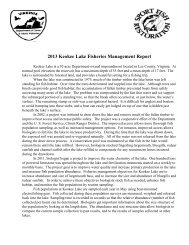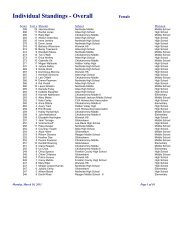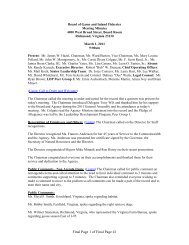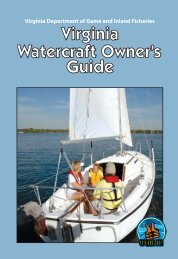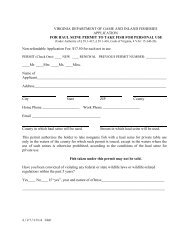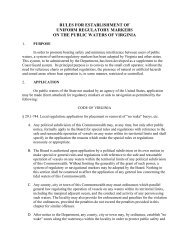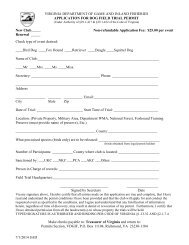2013 Virginia Freshwater Fishing & Watercraft Owner's Guide
2013 Virginia Freshwater Fishing & Watercraft Owner's Guide
2013 Virginia Freshwater Fishing & Watercraft Owner's Guide
You also want an ePaper? Increase the reach of your titles
YUMPU automatically turns print PDFs into web optimized ePapers that Google loves.
<strong>2013</strong> <strong>Fishing</strong> Regs & WOG 11-15-12_Layout 1 11/16/12 1:02 PM Page 61ing safety information, visit our web-site atwww.dgif.virginia.gov/boating/education/.To arrange a free vessel safety check, pleasecall 1-800-245-2628 or contact localUSCGAuxiliary or USPS member.National Safe Boating WeekMay 18–24, <strong>2013</strong><strong>Virginia</strong> Boating SafetyEducation RequirementIn 2007, the <strong>Virginia</strong> General Assemblyenacted a law establishing requirements forboating safety education. This applies to ALLmotorboat operators with a motor of10 horsepower and greater. This requirementwill be phased in over several yearsas follows:Personal <strong>Watercraft</strong> (PWC) “jet-ski”PWC, ALL ages by July 1, 2012Motorboat (MB) 10 hp and greaterMB, age 30 or younger, July 1, 2012MB, age 40 or younger, July 1, <strong>2013</strong>MB, age 45 or younger, July 1, 2014MB, age 50 or younger, July 1, 2015MB, ALL ages, July 1, 2016Do I need to take a boating course?YES – If you have never taken a NASBLAapproved boating safety course and you fallwithin the phase-in schedule (no grand -fathering).NO – If you have previously taken a NASBLAapproved boating safety course and stillhave a card/certificate.NO – If you hold or have held a licenseto operate a vessel (Master, Captain,or Mate).NO – If you are or have been a RegisteredCommercial Fisherman.If your boat is registered in another stateor if are planning to rent a boat visit ourwebsite for more information.Personal <strong>Watercraft</strong> (PWC)OperationA personal watercraft is a motorboat lessthan 16 feet in length which uses an inboardmotor powering a jet pump as its primarymotive power and which is designed to beoperated by a person sitting, standing orkneeling on, rather than in the conventionalmanner of sitting or standing inside thevessel.PWCs must follow all rules and regulationsfor motorboats. There are additionalrules and regulations for PWC operators asfollows:1. It shall be unlawful for any person to operatea PWC, or the owner or any personhaving control to authorize or knowinglypermit a person to operate a PWC, unlessthe operator is at least 16 years of age.Any person age 14 or 15 may operate aPWC if they have successfully completedan approved boating education safetycourse, carry proof of successful completionof such course, and show this proofupon request by a law enforcementofficer.2. It is unlawful to operate a PWC unless theoperator, each rider and anyone beingtowed by a PWC is wearing a Type I, II, III,or V USCG approved life jacket. Inflatablelife jackets are prohibited.3. If the PWC is equipped with a lanyardtypeengine cut-off switch, the operatormust attach the lanyard to his person,clothing, or life jacket.4. It is unlawful to operate a PWC aftersunset or before sunrise.5. It is unlawful to operate a PWC whilecarrying passengers in excess of thenumber for which the craft was designedby the manufacturer; including towedpassengers.6. A person shall be guilty of reckless operationwho operates any PWC recklessly soas to endanger the life, limb, or propertyof any person, which shall include, butnot be limited to: (1) weaving throughother vessels which are underway,stopped, moored or anchored whileexceeding a reasonable speed; (2) followinganother vessel or skier, crossing thepath of another vessel or skier, crossingthe path of another vessel more closelythan is reasonable and prudent; (3) crossingbetween the towing vessel and askier; or (4) steering toward an object orperson and turning sharply in close proximityto such object or person in order tospray or attempt to spray an object or personwith the wash or jet spray of thePWC.7. PWC operators must maintain “no wake”operation when within 50 feet or less ofdocks, piers, boathouses, boat ramps,people in the water and vessels otherthan PWCs. PWCs may tow a skier with arope less than 50 feet. No wake is definedas “The slowest possible speed requiredto maintain steerage and headway”.The above provisions do not apply toparticipants in regattas, races, marineparades, tournaments or exhibitionsapproved by the Board of the VDGIF or theUSCG.Navigation RulesMost boating accidents are the result ofcollision, either between two vessels, orbetween a vessel and a fixed or submergedobject. For this reason, boat operatorsare cautioned to follow the establishedNavigation Rules, especially maintaining aproper lookout and safe speed.Remember the three basic rules ofnavigation:1. Practice Good Seamanship – it is theresponsibility of every vessel or PWCoperator to take all necessary action toavoid collisions. Such action should betaken in ample time to avoid a collisionand at a safe distance from other vessels.2. Keep a Proper Lookout – every operatormust keep a proper lookout using bothsight and hearing at all times. Watch andlisten for other vessels, radio communications,navigation hazards, and othersinvolved in water activities.3. Maintain a Safe Speed – safe speed willvary depending upon conditions suchas wind, water conditions, navigationhazards, visibility, surrounding vesseltraffic, and the maneuverability of yourvessel.The boat operator is responsible for knowingand following all of the applicable navigationalrules. Copies of the rules may beobtained from the Superintendent of Documents,U.S. Government Printing Office,Washington, D.C. 20402, 202-512-1800.The stock number is 050-012-00192-8.On the Web at: http://www.uscg.mil/vtm/navrules/ navrules.pdf.Right Side = StarboardLeft Side = Port(cont. pg. 63)www.HuntFishVA.com 61



